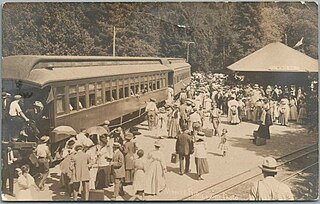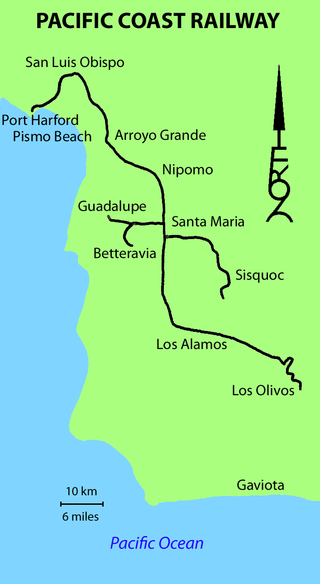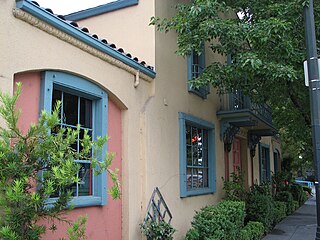
The Pacific Electric Railway Company, nicknamed the Red Cars, was a privately owned mass transit system in Southern California consisting of electrically powered streetcars, interurban cars, and buses and was the largest electric railway system in the world in the 1920s. Organized around the city centers of Los Angeles and San Bernardino, it connected cities in Los Angeles County, Orange County, San Bernardino County and Riverside County.

The interurban is a type of electric railway, with tram-like electric self-propelled rail cars which run within and between cities or towns. The term "interurban" is usually used in North America, with other terms used outside it. They were very prevalent in many parts of the world before the Second World War and were used primarily for passenger travel between cities and their surrounding suburban and rural communities. Interurban as a term encompassed the companies, their infrastructure, their cars that ran on the rails, and their service. In the United States, the early 1900s interurban was a valuable economic institution, when most roads between towns, many town streets were unpaved, and transportation and haulage was by horse-drawn carriages and carts.

The Central California Traction Company is a Class III short-line railroad operating in the northern San Joaquin Valley, in San Joaquin County, California. It is owned jointly by the Union Pacific and BNSF Railway.

The Modesto and Empire Traction Company is a Class III short-line railroad operating in California's San Joaquin Valley. It is owned by the Beard Land & Investment Company; the Beard family has always owned the railroad. The Beards also created the Beard Industrial Park where the MET's customers are located. The railroad was unique in that it had operated for nearly 50 years exclusively with GE 70-ton switchers built between 1947 and 1955; however, a former Southern Pacific EMD SW1500 switcher was added to the roster as of late. The MET operates on 5 miles (8 km) of mainline track, as well as an additional 48.7 miles (78.4 km) of yard and industry track, providing switching services in the Beard Industrial Park. The MET interchanges with the Union Pacific at Modesto and with the BNSF Railway Stockton Subdivision at Empire.
Railroad electrification in the United States began at the turn of the 20th century and comprised many different systems in many different geographical areas, few of which were connected. Despite this situation, these systems shared a small number of common reasons for electrification.
Established in 1908, the Stockton Terminal and Eastern Railroad provides service to several companies around the Stockton area, in San Joaquin County, California.

The East Bay Electric Lines were a unit of the Southern Pacific Railroad that operated electric interurban-type trains in the East Bay region of the San Francisco Bay Area. Beginning in 1862, the SP and its predecessors operated local steam-drawn ferry-train passenger service in the East Bay on an expanding system of lines, but in 1902 the Key System started a competing system of electric lines and ferries. The SP then drew up plans to expand and electrify its system of lines and this new service began in 1911. The trains served the cities of Berkeley, Albany, Emeryville, Oakland, Alameda, and San Leandro transporting commuters to and from the large Oakland Pier and SP Alameda Pier. A fleet of ferry boats ran between these piers and the docks of the Ferry Building on the San Francisco Embarcadero.

The Sacramento Northern Railway was a 183-mile (295 km) electric interurban railway that connected Chico in northern California with Oakland via the California capital, Sacramento. In its operation it ran directly on the streets of Oakland, Sacramento, Yuba City, Chico, and Woodland and ran interurban passenger service until 1941 and freight service into the 1960s.

The Glendale and Montrose Railway Company (G&M) was an interurban electrified railway in Southern California, in the United States. It was unique among the Los Angeles local railways, as it was among the area's only interurban line never absorbed into the expansive Pacific Electric system.

The North Pacific Coast Railroad (NPC) was a common carrier 3 ft (914 mm) narrow-gauge steam railroad begun in 1874 and sold in 1902 to new owners who renamed it the North Shore Railroad (California) (NSR) and which rebuilt the southern section into a standard-gauge electric railway.

The Pacific Coast Railway was a 3 ft narrow gauge railway on the Central Coast of California. The original 10-mile (16 km) link from San Luis Obispo to Avila Beach and Port Harford was later built southward to Santa Maria and Los Olivos, with branches to Sisquoc and Guadalupe.

Petaluma and Santa Rosa Railroad was a 600 volt DC electric interurban railway in Sonoma County, California, United States. It operated between the cities of Petaluma, Sebastopol, Forestville, and Santa Rosa. Company-owned steamboats provided service between Petaluma and San Francisco.
The Rock Island Southern Railway, or RIS, was one of the most unusual interurban systems in the United States. It consisted of two distinct divisions, each with its own unique operating parameters. It provided passenger service to the western Illinois cities of Rock Island, Monmouth and Galesburg for two decades, with freight service surviving into the 1950s on the barest remnants of a once-impressive system.
The Youngstown and Ohio River Railroad, or Y&OR, was one of the smaller interurban railways in the state of Ohio. Along with the Youngstown and Southern Railway, the Y&OR formed a traction link between Youngstown, Ohio and the Ohio River at East Liverpool. It served several coal mines in the area and it was distinguished by the unusual feat of electrifying a section of a steam railroad, the Pittsburgh, Lisbon and Western Railroad, as part of a trackage rights agreement. The Y&OR operated for 24 years.

The Visalia Electric Railroad, a wholly owned subsidiary of the Southern Pacific Railroad (SP), began as an electric interurban railroad in Tulare County, in the U.S. State of California. The railroad was incorporated on April 22, 1904. Passenger service was discontinued in 1924, and the electrification was removed in 1944. Subsequent operation was by diesel locomotive. The railroad was closed in 1992.

Oregon Pacific Railroad is a short-line railroad operating two disconnected routes: one in southeast Portland, Oregon, and another incorporating portions of the former Southern Pacific Molalla Branch between Canby and Liberal, Oregon.

The Salt Lake, Garfield & Western Railway, nicknamed through most of its history as The Saltair Route, is a short line railroad located in Salt Lake City, Utah. Originally incorporated as a dual passenger and freight railroad, it now provides freight-only railcar switching services to industries in Salt Lake City along its sixteen miles of track.

The Southern California Railway Museum, formerly known as the Orange Empire Railway Museum, is a railroad museum in Perris, California, United States. It was founded in 1956 at Griffith Park in Los Angeles before moving to the former Pinacate Station as the "Orange Empire Trolley Museum" in 1958. It was renamed "Orange Empire Railway Museum" in 1975 after merging with a museum then known as the California Southern Railroad Museum, and adopted its current name in 2019. The museum also operates a heritage railroad on the museum grounds.

















